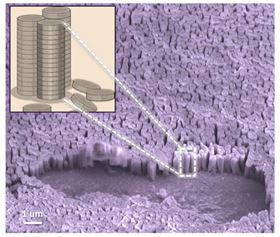 Image credit: UMass AMherst
Image credit: UMass AMherstA simple technique that allows nanopillars to grow like piles of coins on a bank counter could allow materials scientists to cash in on a new approach to solar cells. Alejandro Briseno of the University of Massachusetts Amherst took a biomimetic approach to constructing their solar cell and likens the growth of the nanoscopic piles of coins to blades of grass, which are among nature's most efficient light-harvesting plant structures.
Briseno, with colleagues and graduate students at UMass Amherst and others at Stanford University and Dresden University of Technology, Germany, explain how they have taken a step towards a long-sought polymer architecture that can offer high power-conversion efficiency. [Briseno et al., Nano Lett, 2014, online; DOI: 10.1021/nl501933q]
They used single-crystalline organic nanopillars and found a way to avoid the formation of discontinuous pathways in the bulk that would otherwise reduce efficiency when the system is used in a bulk heterojunction donor-acceptor, positive-negative (p-n), junction in an organic solar cell. The approach also solves instability problems seen where materials in mixed blends of polymers eventually lose their phase-separated behavior over time and so energy transfer degrades. The same approach should find utility in batteries and vertical transistors too Briseno suggests.
To control the architecture of the system and the molecular orientation and packing at the electrode surface, the team used graphene to support the organic crystals, although it was only by serendipity and a student error that this material was used in the experiments rather than the more conventional substrates with which the team had been working. Scanning electron microscopy revealed the details of what the team had grown and they could then optimize growth conditions once they had determined the mechanism of crystallization. The fact that the "blades of grass" resemble stacked coins means they have the largest charge transport anisotropy possible. In this setup electron flow is faster up the nanopillars, perpendicular to the substrate.
Briseno says that vertical nanopillars represent something of an ideal geometry for light absorption, charge separation and collection. "Our systems share similar attributes of grass such as high density array system, vertical orientations and the ability to efficiently convert light into energy," Briseno says.
The technique is simple, inexpensive and applicable to a library of donor and acceptor compounds that are commercially available, Briseno adds. "We envision that our nanopillar solar cells will appeal to low-end energy applications such as gadgets, toys, sensors and short lifetime disposable devices."
David Bradley blogs at Sciencebase Science Blog and tweets @sciencebase, he is author of the popular science book "Deceived Wisdom".